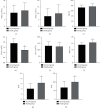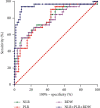Value of Neutrophil to Lymphocyte Ratio, Platelet to Lymphocyte Ratio, and Red Blood Cell Distribution Width in Evaluating the Prognosis of Children with Severe Pneumonia
- PMID: 34603463
- PMCID: PMC8486541
- DOI: 10.1155/2021/1818469
Value of Neutrophil to Lymphocyte Ratio, Platelet to Lymphocyte Ratio, and Red Blood Cell Distribution Width in Evaluating the Prognosis of Children with Severe Pneumonia
Retraction in
-
Retracted: Value of Neutrophil to Lymphocyte Ratio, Platelet to Lymphocyte Ratio, and Red Blood Cell Distribution Width in Evaluating the Prognosis of Children with Severe Pneumonia.Evid Based Complement Alternat Med. 2023 Jun 21;2023:9827598. doi: 10.1155/2023/9827598. eCollection 2023. Evid Based Complement Alternat Med. 2023. PMID: 37388079 Free PMC article.
Abstract
Objective: To investigate the value of neutrophil to lymphocyte ratio (NLR), platelet to lymphocyte ratio (PLR), and red blood cell distribution width (RDW) in evaluating the prognosis of children with severe pneumonia (SP).
Methods: A retrospective analysis of the data of 91 children with SP admitted to our hospital from March 2018 to March 2021. According to the survival status after 28 days of treatment, all children were divided into the survival group (n = 59) and the death group (n = 32). The clinical data and laboratory indicators of the patients were recorded. Multivariate logistic regression was used to analyze the risk factors of prognosis, and the ROC curve was used to analyze the predictive value of each index.
Results: The Acute Physiology and Chronic Health Evaluation II (APACHE II) score and CURB-65 score of the death group were higher than those of the survival group (P < 0.05). The RDW, NLR, PLR, and high-sensitivity C-reactive protein, procalcitonin blood lactic acid (Lac) of the death group, were higher than those of the survival group, and LYM was lower than the survival group (P < 0.05). Multivariate regression analysis showed that APACHE II score, RDW, NLR, PLR, and Lac were all independent risk factors for poor prognosis in children with SP (P < 0.05). The AUC of NLR, PLR, and RDW for evaluating the prognosis of children with SP were 0.798, 0.781, and 0.777, respectively. The sensitivity was 56.25%, 90.63%, and 56.25%, respectively, and the specificity was 89.83%, 55.93%, and 91.53%, respectively. The AUC of NLR, PLR, and RDW combined to evaluate the prognosis of children with SP was 0.943. When the best cut-off value was 0.8528, the sensitivity was 93.75%, and the specificity was 91.53%.
Conclusion: NLR, PLR, and RDW have certain predictive value for the prognosis of children with SP; the combination of the three indicators has a higher value in evaluating the prognosis of children with SP, which can better guide the prognostic treatment.
Copyright © 2021 Xuejiao Qi et al.
Conflict of interest statement
The authors declare no conflicts of interest, financial or otherwise.
Figures





Similar articles
-
[Predictive value of neutrophil to lymphocyte ratio on 28-day mortality of patients with severe pneumonia].Zhonghua Wei Zhong Bing Ji Jiu Yi Xue. 2019 Jul;31(7):827-831. doi: 10.3760/cma.j.issn.2095-4352.2019.07.006. Zhonghua Wei Zhong Bing Ji Jiu Yi Xue. 2019. PMID: 31441404 Chinese.
-
The value of preoperative neutrophil-to-lymphocyte ratio, platelet-to-lymphocyte ratio, and red blood cell distribution width in predicting positive surgical margin after laparoscopic radical prostatectomy.Cancer Rep (Hoboken). 2024 Jan 23;7(2):e1977. doi: 10.1002/cnr2.1977. Online ahead of print. Cancer Rep (Hoboken). 2024. PMID: 38258491 Free PMC article.
-
[Combined prognostic value of serum lactic acid, procalcitonin and severity score for short-term prognosis of septic shock patients].Zhonghua Wei Zhong Bing Ji Jiu Yi Xue. 2021 Mar;33(3):281-285. doi: 10.3760/cma.j.cn121430-20201113-00715. Zhonghua Wei Zhong Bing Ji Jiu Yi Xue. 2021. PMID: 33834968 Chinese.
-
Clinical value of blood related indexes in the diagnosis of bacterial infectious pneumonia in children.Transl Pediatr. 2022 Jan;11(1):114-119. doi: 10.21037/tp-21-568. Transl Pediatr. 2022. PMID: 35242657 Free PMC article.
-
The value of hemoglobin-to-red blood cell distribution width ratio (Hb/RDW), neutrophil-to-lymphocyte ratio (NLR), and platelet-to-lymphocyte ratio (PLR) for the diagnosis of nasopharyngeal cancer.Medicine (Baltimore). 2021 Jul 16;100(28):e26537. doi: 10.1097/MD.0000000000026537. Medicine (Baltimore). 2021. PMID: 34260530 Free PMC article.
Cited by
-
Platelet mass index, systemic immune-inflammation index, and neutrophil-lymphocyte ratio as practical markers in childhood brucellosis.Rev Paul Pediatr. 2025 Jan 17;43:e2024123. doi: 10.1590/1984-0462/2025/43/2024123. eCollection 2025. Rev Paul Pediatr. 2025. PMID: 39841697 Free PMC article.
-
Association Between the Red Blood Cell Distribution Width and 30-Day Mortality in Intensive Care Patients Undergoing Cardiac Surgery: A Retrospective Observational Study Based on the Medical Information Mart for Intensive Care-IV Database.Ann Lab Med. 2024 Sep 1;44(5):401-409. doi: 10.3343/alm.2023.0345. Epub 2024 Mar 12. Ann Lab Med. 2024. PMID: 38469636 Free PMC article.
-
Lung Ultrasound and Neutrophil Lymphocyte Ratio in Early Diagnosis and Differentiation between Viral and Bacterial Pneumonia in Young Children.Children (Basel). 2022 Sep 23;9(10):1457. doi: 10.3390/children9101457. Children (Basel). 2022. PMID: 36291392 Free PMC article.
-
Validated Prognostic Scores to Predict Outcomes in ECLS-Bridged Patients to Lung Transplantation.Transpl Int. 2023 Oct 30;36:11609. doi: 10.3389/ti.2023.11609. eCollection 2023. Transpl Int. 2023. PMID: 37965627 Free PMC article.
-
Retracted: Value of Neutrophil to Lymphocyte Ratio, Platelet to Lymphocyte Ratio, and Red Blood Cell Distribution Width in Evaluating the Prognosis of Children with Severe Pneumonia.Evid Based Complement Alternat Med. 2023 Jun 21;2023:9827598. doi: 10.1155/2023/9827598. eCollection 2023. Evid Based Complement Alternat Med. 2023. PMID: 37388079 Free PMC article.
References
Publication types
LinkOut - more resources
Full Text Sources
Research Materials

